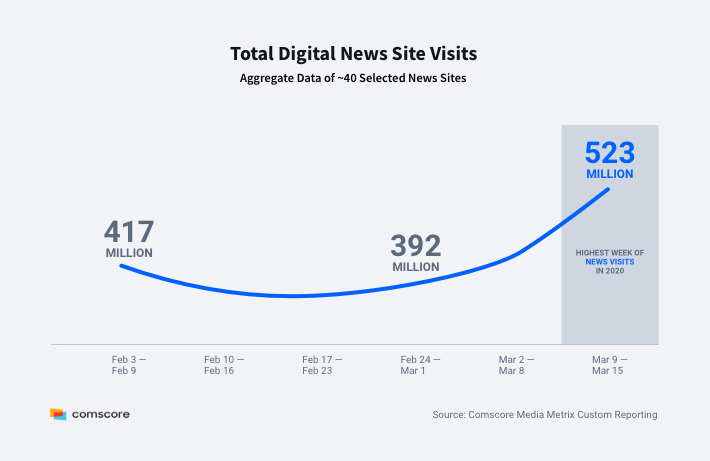Changes in Consumer Behaviour: Responses in Programmatic Advertising

These are truly unprecedented times for individuals and similarly for the products and services they embrace. Understandably so, consumer behaviour is adapting to the situation at hand. Consumer engagement in online content is spiking. And while some advertisers are watching, waiting and deciding, others put shifting strategies and budgets into action. There is no right or wrong answer in your approach. Our role is to help you monitor events, make the right or better strategy decisions, maximize your investment for short-term goals and prepare for a pivot once the crisis is over.
The thing with programmatic advertising is that it is highly flexible. In contrast with other forms of advertising like out of home, event sponsorships, and linear TV, digital campaigns can be turned on or off, creatives adjusted, and optimized in real time depending on performance. This affords you and your clients the luxury and agility to test, with low commitments, while optimizing towards ROI. As a result this approach is more comforting when budgets become more tightly controlled and timely decisions need to be made.
While ad spending is starting to decrease for some industries and markets, it is important to realize that there are benefits of continuing to advertise to help maintain brand recognition, health and strength for the longer term.
Anticipated Changes and Possible Strategic Maneuvers
Brands can help fight the pandemic in this time of crisis, building trust in the process. Companies like Grubhub, Zoom and Verily are all setting the bar with modified services and offerings to support struggling demographics like the hospitality industry, education and healthcare.
These are great examples of brands that are taking action and standing by their values.
Using messaging that’s informative and empathetic can help maintain brand awareness and brand safety while being mindful of the situation at hand.
The current situation is changing rapidly; as a result, consumer habits have shifted and will continue to do so. Be prepared to continually modify your marketing strategies as we continue monitor the changes in consumer behaviours.
Media plans that made sense two weeks ago might not work as planned today. However, set-it-and-forget-it is never a suggested practice, and especially not now.
Some strategies to consider:
- Focus on your online presence and e-commerce. We’ll likely see an uptick in online consumption and have already seen a significant drop in market for nonessential in-store purchases.
- Re-evaluate digital campaigns that are driving people to stores. Brand awareness and upper funnel campaigns are a possible alternative to lower funnel, foot traffic driven approaches.
- Leverage geolocation providers by targeting users who had visited a location prior to self-isolation—adjust the lookback window on targeting segments.
- Get the word out about how you’re transitioning: restaurants and QSRs have either shut down or may be in the coming weeks. For those that offer takeout or delivery to home, customers need to know about those options.
Leverage the Opportunities
Americans stand to watch as much as 60% more television now that increasingly strict coronavirus-related lockdowns and shutdowns are in place in cities around the country, according to an analysis from Nielsen. Remote work will also drive more media consumption.
As consumers continue to self-isolate and stay indoors, traditional media, like out-of-home (OOH) and print will see a decline. Ad spend on radio will also likely decrease as the majority of people are not commuting to work— and we are already seeing a decline. Consumption on digital channels has already increased across all formats, especially time spent streaming video content as users aim to stay entertained at home.

Trends from an inventory partner indicate a 13% uplift in avails from Week 11 to 12 (March 9 and March 16). Compared to data from 30 days ago, CTV avails saw a 33% uplift while ad opportunities from desktop and high-end mobile devices see an uplift of 39% and 12% respectively.
As noted above, the pandemic is causing an increase in digital supply across the open internet, especially on OTT and connected TV (CTV). As the global pandemic takes hold, 36% of consumers say it is a direct driver of them taking out a new OTT subscription. On a macro level, the economy is being directly affected by the pandemic and may cause a contraction in consumer spend and by correlation, advertiser spend. In the programmatic industry, supply is increasing and demand is decreasing, which could result in a buyer’s market where CPMs are naturally lower.

Stay close to your customers. Companies that better navigate disruptions often succeed because they invest in their core customer segments and anticipate their behaviours. Companies should invest in online as part of their push for omnichannel distribution; this includes ensuring the quality of goods sold online. Customers’ changing preferences are not likely to go back to pre-outbreak norms, soon or possibly ever.
Reach Consumers With Effective Messaging
Although it may seem that the easiest course of action as a marketer is to batten down the hatches—cut back, lay low, and not fight a seemingly losing battle at a time when they think consumers don’t want to hear from them. But consumers and the economy need marketers and marketing. Marketers have an opportunity to give consumers a reason to engage—deals, products, services—even when they are hunkered down and isolated. And it is evident that ample opportunities exist to advertise. The key is getting the message right.
So how can you create messages that are informative and empathetic to help maintain brand awareness and brand health, while being mindful of the situation at hand?
This is a sensitive time for consumers, so sounding opportunistic could work to your detriment. Instead of using sales-driven language such as “Buy Now”, focus on what your brand can offer to the community. As a marketer, put yourself in your audiences’ shoes. Consider what is important to them right now and how your brand messaging can provide comfort, safety, convenience, positivity and/or connection. You can even get creative with a bit of humour depending on your brand voice, as people will be craving entertainment and normalcy amid an unstable climate.
For industries that are more heavily impacted such as travel, events and sports, lead with messaging that looks to the future, such as “Add [location] to your bucket list today!” These activities will eventually resume and some consumers will be itching to get back to them which means they may be using this time to gather ideas and plans.
When it comes to messaging, marketers should approach with caution, but not fear. When in doubt, choose neutral brand awareness messaging in order to maintain a dialogue with your consumers so that when the time is right, you will be front of mind. If you are operating normally, and can still drive conversions to your online business, consider adding a dynamic countdown to a sale, or tentpole event to spark excitement, as something to look forward to.
This situation has not only been unprecedented it has been very fluid. Each week and even each day will continue to be different. Marketers need to continue evaluating their budgets, their messages and find new ways to engage with consumers.
Want to run exceptional programmatic campaigns? Request a demo to learn more about StackAdapt.



